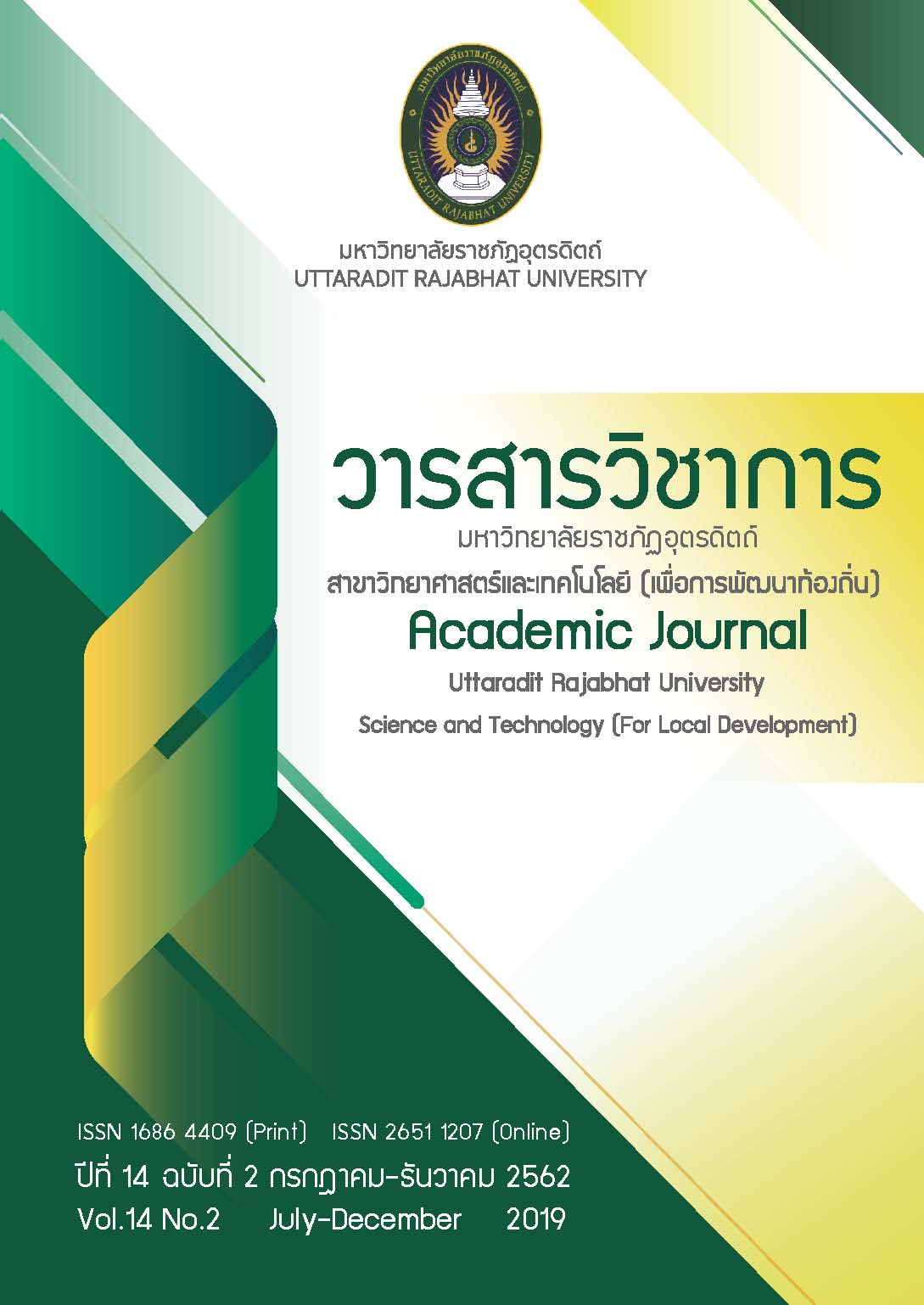การวิเคราะห์เศรษฐศาสตร์โรงไฟฟ้าพลังงานแสงอาทิตย์ 8 เมกกะวัตต์ ระหว่างการติดตั้งแบบระบบคงที่กับแบบระบบติดตามดวงอาทิตย์ในประเทศไทย
Main Article Content
บทคัดย่อ
อัตราการเจริญเติบโตทางเศรษฐกิจของประเทศไทย (GDP) 9 เดือนแรกของปี 2561 ขยายตัว 4.3% ส่งผลต่อภาพรวมการใช้พลังงานขั้นสุดท้ายเพิ่มขึ้น 3.6% คิดเป็นมูลค่ากว่า 1,397,306 ล้านบาท ซึ่งการเจริญเติบโตทางเศรษฐกิจของประเทศส่งผลให้มีการใช้พลังงานไฟฟ้าเพิ่มมากขึ้น การผลิตไฟฟ้าของประเทศไทยใช้ก๊าซธรรมชาติเป็นหลัก แต่ปริมาณก๊าซธรรมชาติในอ่าวไทยกำลังลดลงเรื่อยๆ รัฐบาลจึงมีการสนับสนุนให้มีการรับซื้อไฟฟ้าพลังงานหมุนเวียน เช่น แสงอาทิตย์ ลม น้ำ ชีวมวล ก๊าซชีวภาพ และขยะ จากผู้ผลิตไฟฟ้าเอกชน โดยโรงไฟฟ้าพลังงานแสงอาทิตย์สามารถผลิตไฟฟ้าได้ 25.79% จากการผลิตไฟฟ้าพลังงานหมุนเวียนทั้งหมด ได้รับความนิยมรองจากพลังงานชีวมวลและพลังงานน้ำขนาดใหญ่ โรงไฟฟ้าพลังงานแสงอาทิตย์มีเทคโนโลยีการติดตั้งแผงเซลล์แสงอาทิตย์ 2 ประเภท คือ การติดตั้งแผงเซลล์แสงอาทิตย์แบบระบบคงที่ (Fixed) กับแบบระบบติดตามดวงอาทิตย์ (Tracking) ซึ่งแบบระบบติดตามดวงอาทิตย์จะผลิตไฟฟ้าได้มากกว่าแบบระบบคงที่ คิดเป็น 2.51%
การวิเคราะห์ทางเศรษฐศาสตร์ของโรงไฟฟ้าพลังงานแสงอาทิตย์ทั้งสองแบบ พิจารณาจากมูลค่าปัจจุบันสุทธิ (NPV) ที่อัตราคิดลด 3% พบว่า ทั้งสองแบบมีมูลค่าปัจจุบันสุทธิที่เป็นบวก แสดงว่ามีความคุ้มค่าที่จะลงทุน และอัตราผลตอบแทนต่อต้นทุน (B/C ratio) กับอัตราผลตอบแทนภายใน (IRR) พบว่า โรงไฟฟ้าพลังงานแสงอาทิตย์แบบระบบคงที่เทียบกับแบบระบบติดตามดวงอาทิตย์มีความคุ้มค่าในการลงทุนมากกว่าเล็กน้อย โดยมีอัตราผลตอบแทนต่อต้นทุนเท่ากับ 5.63 และ 5.58 อัตราผลตอบแทนภายในเท่ากับ 31.77% และ 31.39% ตามลำดับ ส่วนการวิเคราะห์ความอ่อนไหวทั้งกรณีต้นทุน การลงทุนสร้างโรงไฟฟ้าแบบระบบคงที่ยังคงมีความคุ้มค่าในการลงทุนมากกว่า
Downloads
Article Details
เอกสารอ้างอิง
กรมพัฒนาพลังงานทดแทนและอนุรักษ์พลังงาน (พพ.) กระทรวงพลังงาน. (2562). สถานการณ์พลังงานของประเทศไทย เดือนมกราคม – ธันวาคม 2561. [ออนไลน์]. แหล่งที่มา https://www.dede.go.th/download/stat62/sit_2_61_dec.pdf (18 พฤษภาคม 2562).
กระทรวงพลังงาน. (2561). สัดส่วนการใช้พลังงานทดแทน (Percentage of Alternative Energy Consumption). [ออนไลน์]. แหล่งที่มา https://www.dede.go.th/download/state_61/1_Energy_Consumption_Jan-May_2561.pdf, (18 พฤษภาคม 2562).
ญาณยุทธ พลชูสกุลวง, ศักดิ์ชาย รักการ, ปพน สีหอมชัย และอนัญญา จินดาวัฒนะ. (2557). การศึกษาความเป็นไปได้ในการสร้างโรงไฟฟ้าจากพลังงานแสงอาทิตย์ กรณีศึกษา : อำเภอกุดรัง จังหวัดมหาสารคาม. วารสารวิชาการ วิศวกรรมสารเกษมบัณฑิต. 4 (1): 41-57.
ดารัตน์ บุญมะ. 2549. การวิเคราะห์การลงทุนในการพัฒนาและการจัดการทรัพยากรมนุษย์ในองค์กร กรณีศึกษา : องค์กร Clinical Research Organization. วิทยาศาสตรมหาบัณฑิต วิทยาลัยนวัตรรมอุดมศึกษา: มหาวิทยาลัยธรรมศาสตร์.
บดินทร์ เสนานนท์, กัญญานัฐ ทองเทพ, กมล จิรเสรีอมรกุล, วันจักรี์ เล่นวารี, เสริมสุข บัวเจริญ และ ยิ่งรักษ์ อรรถเวชกุล. (2561). การเปรียบเทียบโรงไฟฟ้าพลังงานแสงอาทิตย์ขนาด 8 เมกกะวัตต์ที่ติดตั้งแบบระบบคงที่และระบบติดตามดวงอาทิตย์ในประเทศไทย. การประชุมวิชาการเครือข่ายพลังงานแห่งประเทศไทยครั้งที่ 14. ระยอง. 1,117-1,121.
สุรกิจ ทองสุก และอรรถพล เง่าพิทักษ์กุล. (2561). การศึกษาประสิทธิภาพและความคุ้มทุนของระบบผลิตไฟฟ้าด้วยเซลล์แสงอาทิตย์ที่ติดตั้งบนหลังคา. วารสารมหาวิทยาลัยศรีนครินทรวิโรฒ (สาขาวิทยาศาสตร์และเทคโนโลยี). 10(9): 157-169.
Abol Ardalan. 1999. Economic and Financial Analysis for Engineering and Project Management. Boca Raton: CRC Press.
D.L. Talavera, Emilio Munoz-Ceron, J.P. Ferrer-Rodríguez and Pedro J. Perez-Higueras. (2019). Assessment of cost-competitiveness and profitability of fixed and tracking photovoltaic systems: The case of five specific sites. Renewable Energy. 134(2019): 902-913.
Hyuna Kang, Taehoon Hong, Seunghoon Jung and Minhyun Lee. (2019). Techno-economic performance analysis of the smart solar photovoltaic blinds considering the photovoltaic panel type and the solar tracking method. Energy & Buildings. 193(2019): 1–14.


